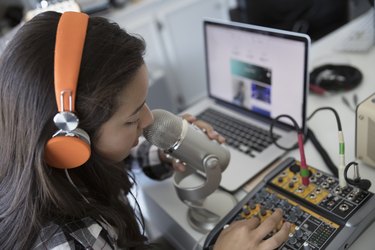
These are good days to be a self-recorded musician. Record companies and major-label artists may struggle to find their way in the new world, but it's never been easier to create professional-quality recordings at home and get them out to your audience. Your laptop provides all the recording capability you need, and recording from a mixer to a laptop is a straightforward process.
It's All About the Inputs
Video of the Day
Laptops usually have only one audio input. That's the mic jack positioned alongside the headphone jack. It's OK for making video calls or for talking smack with your friends while you're playing online games, but it's limited for serious audio. Aside from allowing you to record from only one device at a time, the analog-to-digital converters on your average sound card aren't of professional quality. Working through a mixer neatly solves both problems. It gives you the variety of inputs you need for your instruments and microphones, and most modern mixers let you bypass the microphone jack and connect the mixer to your laptop through a USB port.
Video of the Day
Use an Existing Mixer
If you already have a mixer and want to use it with your laptop, take a look at the mixer's connections. Current or recent models have one or more USB connectors somewhere, usually on the back. A flat connector, like the ones on your laptop, is usually intended as an input. You're looking instead for the kind that's rounded and D-shaped like you'd find on a printer. If you don't have one, you need to go from the mixer's analog output to your computer. Depending on the mixer and its vintage, you may have a headphone-style 1/4-inch plug or a pair of red and white RCA jacks or both. Pick up an appropriate cable to go from that to the 3.5 mm input on your laptop. It's functional, though not ideal because now you're back to recording through your sound card. A better option is to run from the mixer to a separate audio interface and then to your laptop's USB port, or budget for a new mixer.
Picking a New Mixer
If you're picking out a new mixer specifically for recording, then any compromises you make will be budget related, not caused by your hardware. Take a serious look at how many things you want to connect to the mixer and the kind of connections they need: balanced and unbalanced microphone jacks, line-level connections for your instruments, S/PDIF or ADAT connectors for digital connections, and so on. Search out mixers that have the inputs you need – and ideally a few extra for things you may need in future but don't know about yet – and see what fits your budget.
Recording From Mixer to Laptop
The final thing you need to record from your mixer is a suitable audio program. There are lots of choices available depending on your needs and your budget. If you're buying a mixer or an audio interface as part of your setup, it may come with a commercial program included as part of the price. That makes your choice easy. If not, you can buy one or pick a free program. One option is a free, open-source program called Audacity. It's hugely popular, so there's plenty of help and advice out there on the internet to get you up and running. You can also start with the free versions of mainstream programs like Studio One or Pro Tools, which offer enough functionality for a beginner. A big advantage of that choice is that as your needs grow, you can upgrade to the paid version instead of learning a whole new program.
Live Option
One of the intriguing possibilities you can look into is recording a live performance instead of laying down tracks in your basement or garage. Recording audio from a venue's soundboard to your computer is much the same as recording from your mixer to a laptop. How you approach it depends on the equipment you're working with. If you have your own board, and it's reasonably modern, it may have a USB output. If not, or if you're working with the venue's board, which might well be older than you are, you need to bring along your own mixer or a separate audio interface and connect from that to your laptop just as you would at home.
- Intel: Choosing the Best Laptop for Music Production
- Tunecore: How to Set Up a Home Recording Studio - The Complete Guide
- The Hub: Audio Interface Buying Guide
- Alesis: Multimix 8 USB FX
- Behringer: XENYX Q802USB Analog Mixer
- Audacity: Free, Open Source, Cross-Platform Audio Software
- Presonus: Studio One 4 Prime
- Avid: Pro Tools First